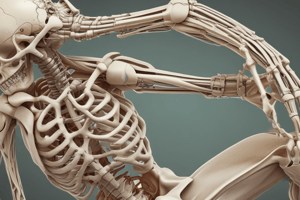Podcast
Questions and Answers
What is the main function of the bursae in synovial joints?
What is the main function of the bursae in synovial joints?
- To provide structural support to the joint
- To increase movement in the joint
- To produce synovial fluid
- To reduce friction between structures (correct)
Which type of synovial joint permits movement in two planes?
Which type of synovial joint permits movement in two planes?
- Saddle joint (correct)
- Pivot joint
- Plane joint
- Hinge joint
What is the characteristic of the articular surfaces in plane joints?
What is the characteristic of the articular surfaces in plane joints?
- Cylindrical
- Concave and convex
- Saddle-shaped
- Opposed flat surfaces (correct)
What type of joint is the elbow joint?
What type of joint is the elbow joint?
What is the function of the synovial fluid in synovial joints?
What is the function of the synovial fluid in synovial joints?
What is the term for inflammation of a bursa?
What is the term for inflammation of a bursa?
What is a characteristic of synovial joints that allows for greater mobility?
What is a characteristic of synovial joints that allows for greater mobility?
What is the primary function of the articular cartilage in synovial joints?
What is the primary function of the articular cartilage in synovial joints?
What is the purpose of the joint capsule in synovial joints?
What is the purpose of the joint capsule in synovial joints?
Which of the following is NOT a characteristic of synovial joints?
Which of the following is NOT a characteristic of synovial joints?
What is the main difference between the axial skeleton and the appendicular skeleton in terms of synovial joints?
What is the main difference between the axial skeleton and the appendicular skeleton in terms of synovial joints?
What is the role of ligaments and tendons in synovial joints?
What is the role of ligaments and tendons in synovial joints?
What is the primary factor that determines the type of movement occurring at a joint?
What is the primary factor that determines the type of movement occurring at a joint?
Which of the following joints is characterized by multiple axes of movement, with one axis predominating?
Which of the following joints is characterized by multiple axes of movement, with one axis predominating?
What is the term for the movement of a joint in multiple directions?
What is the term for the movement of a joint in multiple directions?
Which of the following joints is characterized by movement in only two axes?
Which of the following joints is characterized by movement in only two axes?
What is the primary function of the articular cartilage in synovial joints?
What is the primary function of the articular cartilage in synovial joints?
Which of the following joints is characterized by movement in one axis only?
Which of the following joints is characterized by movement in one axis only?
Flashcards are hidden until you start studying
Study Notes
Synovial Joints and Synovial Membrane
- A synovial membrane lines the joint cavity, except over the articular cartilage.
- The membrane produces synovial fluid, a complex mixture of polysaccharides, proteins, lipids, and cells.
- Synovial fluid forms a thin, lubricating film covering the surfaces of the joint.
Bursae
- A synovial membrane may extend as a pocket, or sac, called a bursa, which reduces friction between structures that rub together.
- Examples of bursae include those located where a tendon crosses a bone.
- Inflammation of a bursa is called bursitis.
Types of Synovial Joints
- Synovial joints are classified according to the shape of the adjoining articular surfaces.
- Plane joints, or gliding joints, consist of two opposed flat surfaces that glide over each other.
- Examples of plane joints are the articular facets between vertebrae.
- Saddle joints consist of two saddle-shaped articulating surfaces oriented at right angles to each other.
- Examples of saddle joints include the joint between the metacarpal bone and the carpal bone (trapezium) of the thumb.
- Hinge joints permit movement in one plane only.
- Examples of hinge joints include the elbow and knee joints.
Characteristics of Synovial Joints
- Synovial joints are freely movable joints that contain fluid in a cavity surrounding the ends of articulating bones.
- Most joints that unite the bones of the appendicular skeleton are synovial joints.
- Articular surfaces of bones within synovial joints are covered with a thin layer of articular cartilage.
- The articular surfaces are enclosed within a fluid-filled joint cavity.
- The joint cavity is surrounded by a joint capsule, which helps hold the bones together.
- Portions of the fibrous part of the joint capsule may be thickened to form ligaments.
- Ligaments and tendons outside the joint capsule contribute to the strength of the joint.
Studying That Suits You
Use AI to generate personalized quizzes and flashcards to suit your learning preferences.



